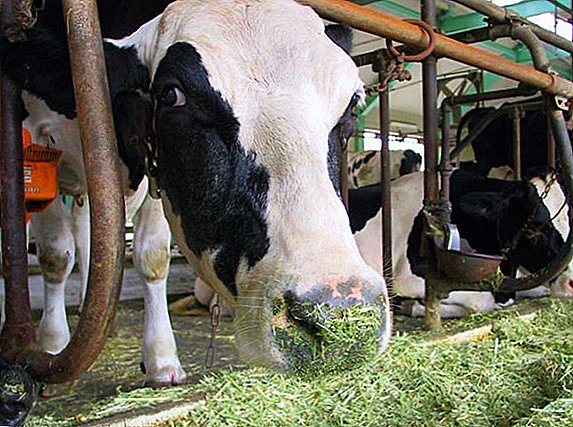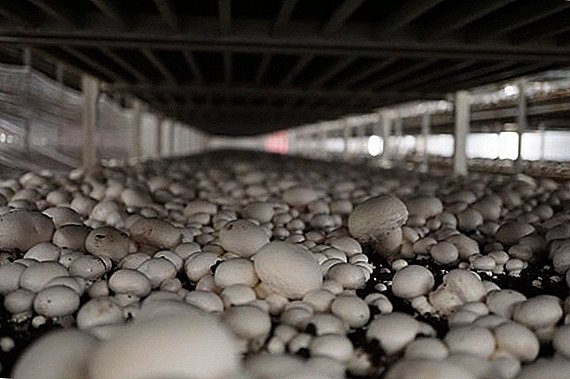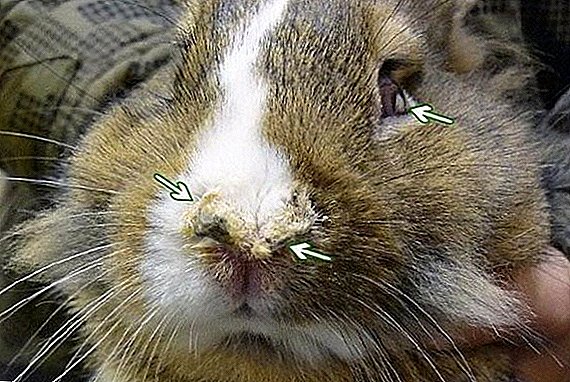 Lungs in rabbits are very sensitive. They quickly react to the conditions in which the animal is contained and what it breathes. Any problem with the lungs is a serious threat to the life of the eared.
Lungs in rabbits are very sensitive. They quickly react to the conditions in which the animal is contained and what it breathes. Any problem with the lungs is a serious threat to the life of the eared.
Therefore, it is very important to monitor the state of respiration of the animal and listen to extraneous sounds. The rabbit's grunting is most often said about lung problems.
Should I worry if the rabbit grunts
Often the owners of rabbits, when they hear their pet grunt, start to panic. But before you guess what disease struck your pet, watch him. For rabbits, especially decorative breeds, it is absolutely normal to grunt when they are irritated or unhappy with something. Unsterilized individuals may also grunt during mating games. Grind eared can, when approaching each other or when moving towards the owner. In any of these situations, the rabbit grunts for a short time. The rest of the time, he breathes absolutely normal.  If the sounds of poking or snoring emanate from the eared constantly and in addition are accompanied by mucous secretions from the mouth and nose, then it is urgent to carry the pet to the veterinarian. Such a picture may signal the beginning of rhinitis, lung injury or infectious diseases.
If the sounds of poking or snoring emanate from the eared constantly and in addition are accompanied by mucous secretions from the mouth and nose, then it is urgent to carry the pet to the veterinarian. Such a picture may signal the beginning of rhinitis, lung injury or infectious diseases.
Did you know? Decorative and ordinary rabbits have a different structure of internal organs.
The reasons why the rabbit is breathing heavily
Changes in eared respiration can be associated with mechanical or infectious lesions of the lungs. More on this in more detail below.
Injuries
Eared can injure the lungs by falling from a height or if a heavy object falls on it or if the chest is pinched by the door. Also, the bite of a large animal (dog) can cause lung injury, breaking the capillaries, which often leads to the discovery of bleeding, the appearance of congestive and inflammatory processes, pneumothorax. These hazards can trap the animal and at home, and during a walk.
Learn about common diseases of the ears and eyes in rabbits.The following symptoms indicate a lung injury:
- frequent and heavy breathing (eared breathing is difficult);
- lethargy;
- if bleeding has opened, mucous membranes turn pale (anemia);
- loss of appetite or complete loss of it;
- with the beginning of pathological changes in the body, wheezing may occur.
 It is possible to diagnose an injury definitively only by collecting the patient’s history, examining it and taking X-rays. Treatment is prescribed by a veterinarian after establishing an accurate diagnosis. The following drugs may be prescribed:
It is possible to diagnose an injury definitively only by collecting the patient’s history, examining it and taking X-rays. Treatment is prescribed by a veterinarian after establishing an accurate diagnosis. The following drugs may be prescribed:
- heart drugs (Sulfocamphocain, Caffeine);
- hemostatic ("Etamzilat", "Decinon", "Vikasol");
- anti-inflammatory ("Dexamethasone", "Dexfort", "Traumeel", "Travmatin");
- if there is an inflammatory process, then, most likely, antibiotics will be prescribed.
Important! Only a doctor can diagnose a lung injury, as well as prescribe a course of treatment. You cannot treat a pet yourself.
Diseases
Very often, eared lungs cause infectious and fungal diseases.
Pasteurellosis
The causative agent of the disease is Gram-negative bacillus Pasteurella multocida. It affects the eared upper respiratory tract. The disease occurs in two forms: acute and chronic. In the first case, the disease manifests itself suddenly, and its course is fast. All mucous membranes are filled with blood. In the second form, the disease is localized in the respiratory tract and the digestive tract.  Symptoms of the acute form:
Symptoms of the acute form:
- sudden increase in body temperature to 41-42 degrees;
- redness of the mucous membranes;
- complete loss of appetite;
- depressed look;
- the animal dies within 1-2 days after infection.
 Symptoms of chronic form:
Symptoms of chronic form:- loss of appetite or complete loss of it;
- lethargy;
- congestion of mucus or inflammatory process with pus in the lungs, because of which the rabbit wheezes and breathes heavily;
- diarrhea / constipation;
- rhinitis;
- the body is depleted, and a week later the animal dies.
Video: Symptoms and prevention of pasteurellosis
An acute form of the disease cannot be cured, since it occurs suddenly and quickly ends in a lethal outcome.
Read more about pasteurellosis in rabbits.
After the death of the first specimen, its carcass must be given for laboratory tests to establish a diagnosis, and for the others, a course of treatment is given:
- Sulfonamides (0.2-0.3 g for an adult animal and 0.1-0.2 g for a young for 3-4 days).
- "Tetracycline" or "Biomitsin" (25 thousand units per kilogram of body weight twice a day intramuscularly for 3-4 days).
- It is possible to combine sulfonamides with antibiotics (3 days sulfonamides, 3 days antibiotics intramuscularly, 3 days again sulfonamides).
Aspergillosis
Fungal infection of the respiratory tract. Spread on the brain, kidneys, eyes and skin is possible. Mushrooms of the genus Aspergillus are found in soil, flour, moldy grain, industrial dust, water, and wooden products. The most vulnerable to infection are rabbits with a weakened immune system. The disease develops slowly. 
Symptoms:
- lethargy;
- depressed state;
- loss of appetite;
- frequent and heavy breathing;
- discharge from the eyes and nose;
- convulsions, then paralysis and death.
Important! A sick animal must be shown to a veterinarian, since the symptoms are similar to tuberculosis and pseudotuberculosis.Ailment is not amenable to treatment. It is only possible to prevent its spread. Animals are given iodine preparations (iodine monochloride, potassium iodine, "Iodinol", "Lugol"), "Nystatin", "Amphotericin". They are mixed in water or feed.

Find out what diseases of rabbits are dangerous to humans.
Preventive measures
So that your pets are not sick, you need:
- Give only high-quality food and make sure that the diet is balanced.
- Ensure proper conditions of detention (ventilation of the room, regular disinfection, extermination of rodents and insects, do not keep animals crowded).
- To conduct timely deworming and vaccination.
- Take measures to prevent injuries in ornamental eared ones (remove dangerous objects, monitor children and dogs).












